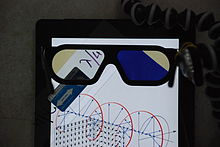This article needs additional citations for verification. (March 2010) |

A polarized 3D system uses polarization glasses to create the illusion of three-dimensional images by restricting the light that reaches each eye (an example of stereoscopy).
To present stereoscopic images and films, two images are projected superimposed onto the same screen or display through different polarizing filters. The viewer wears low-cost eyeglasses with a polarizing filter for each eye. The left and right filters have different polarizations, so each eye receives only the image with the matching polarization. This is used to produce a three-dimensional effect by projecting the same scene into both eyes, but depicted from slightly different perspectives with different polarizations. Multiple people can view the stereoscopic images at the same time.
Polarized 3D systems, and stereoscopy systems in general, commonly exhibit the Vergence-Accommodation Conflict.[1]
- ^ "Resolving the Vergence-Accommodation Conflict in Head-Mounted Displays" (PDF). 2022-09-22. Archived from the original (PDF) on 2022-09-22. Retrieved 2022-09-22.